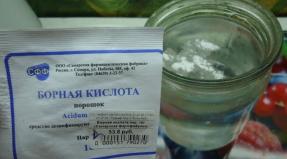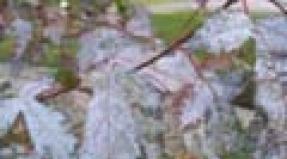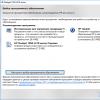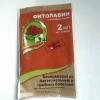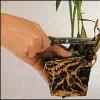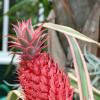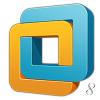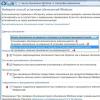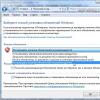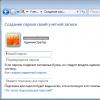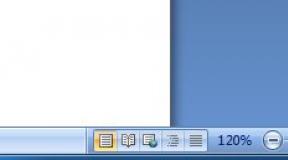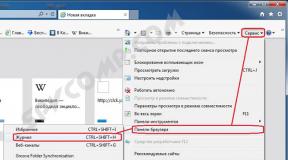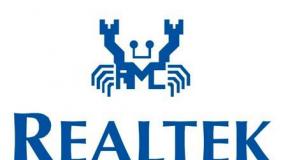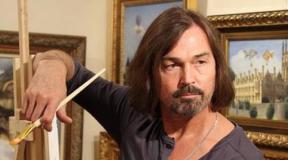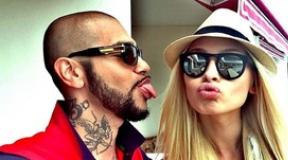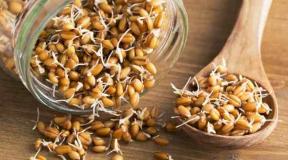МКБ: osteochondrosis of the spine. Disease code and description. Methods of combating osteochondrosis in the lumbar department who are subject to the disease
A lot of achievements to a person brought civilization. But for everything you need to pay. A modern man pays what he has (how he himself thinks in naughtness) in excess - health.
And today, osteochondrosis of the spine has become one of the most common ways of payment of a person for progress. Here we have already covered the question of medical treatment different species Chondrose.
First of all, what is osteochondrosis?
The disease begins with deterioration of trophic (nutrition) of intervertebral discs and the vertebrals themselves, which leads to a violation of the normal structure of tissues.
Because of this process, the elasticity of the disk consisting of cartilage decreases, the structure and form changes. Naturally, fewer intervals between the vertebra are becoming, and the affected department of the spine becomes unstable.
The process of dystrophic changes in the spine is accompanied by squeezing the nerve roots, which come out from the spinal channel through the intervertebral holes, and an increase in the tension of the spine muscles. This can explain the occurrence of pain and neurological symptoms during osteochondrosis.
The intervertebral disc is concluded in the so-called fibrous ring. Accordingly, the dystrophic changes occurring in it can lead to the fact that the fibrous ring itself weakens, and this, in turn, can lead to a different kind of complications.
For example, with osteochondrosis of the lumbar department, intervertebral hernias can form, and the cervical osteochondrosis may worsen the functioning of the brain.
Causes of the development of this disease
First of all, these are factors associated with too high load on the spine:
- excess weight;
- long work associated with the lifting and movement of cargo by hand;
- profession requiring long stay in a static pose;
- permanent walking on too high heels, Asymmetric load on the vertebrate (for example, wearing a bag or a backpack only on one shoulder);
- constant scene in a horn position and so on.
Immediately after them go:
- spinal injuries
- nutrition with insufficient content of vitamins and mineral connections (especially vitamins D, C, group B, as well as calcium and phosphorus),
- bad habits (as they contribute to an increase in the loss of trace elements),
- sleep on uncomfortable mattresses and pillows.
A separate string in the list of patients with osteochondrosis of the spine cost professional athletes. This is because with intense physical exertion, wear of ligaments, joints, intervertebral disks are accelerated.
And these processes go much faster than an ordinary person.
Code of the ICD - What is it?
 Diseases that overcome people differ in stages, severity, nature, localization, and so on. And the further science walks, the more such differences are revealed.
Diseases that overcome people differ in stages, severity, nature, localization, and so on. And the further science walks, the more such differences are revealed.
And that the doctors of the whole world it is easier to work with them, an international classification of diseases (ICD) was created
For the first time, the ICD saw the light in 1893 with the filing of the Association public Health USA. However, its creator is the head of the Statistical Service of Paris Jacques Bertillon.
To date, the whole world enjoys the ICD of the tenth revision (ICD-10). By 2018, it is expected to be the beginning of the application of a new classification, which is now in development - ICD-11.
The main goal of the International Classification of Diseases is the provision of opportunities for systemic generalization of knowledge and data on the prevalence of diseases in different countriesoh.
The ICD makes it possible to present the formulation of diagnoses of diseases and problems associated with health, to a common denominator expressed in codes, and this makes the process of accumulation, storage, analysis, interpretation and comparisons of data universal.
Also, the International Classification of Diseases allows to solve the problem of generalizing and classifying diseases internationally.
The ICD is an international standard diagnostic classification, which is used in drafting mortality statistics and incidence in the countries who have adopted countries.
Main differences MKB-10
The main differences between the ICD-10 from the ICD-9 lies in the following:
- In ICB-10, the principle of disease coding was first applied Using one letter and three or four digits, separated by a point. This gave the opportunity to encode up to 100 three-digit categories in each class.
- Of all the available letters of the Latin alphabet in the CDC codes used 25. As a backup stored letter U.
- Another pretty an important point Included in the end of a number of classes of diseases The list of columns for violations that may arise after medical interventions.
Osteochondrosis forms in international classification
According to the ICD-10, the osteochondrosis of the spine refers to the XIII class of diseases of the "disease muscular system and connective tissue"(M00-M00 codes)," deforming "subclasses (M40-M43 codes).
Actually, the osteochondrosis of the spine is placed in the ICD-10 under the code M42.
There are the following varieties of osteochondrosis:
- M42.0 x Youth Osteochondrosis of the Spine,
- M42.1 x osteochondrosis of the spine in adults,
- M42.9 x osteochondrosis of the spine is unspecified.
Several spinal lesion zones are isolated, each of which is denoted by the corresponding number, which is the fourth in a row in the code of the disease and is placed on the site "X":

- .x0 - multiple spine departments
- .x1 - Scoping area, first and second cervical vertebrae
- .x2 - Neck area
- .x3 - Shane and Breast Department
- .x4 - Breast Department
- .x5 - lumbar-breast department
- .x6 - Lumbar Department
- .x7 - Lumbar-sacral department
- .x8 - sacral and sacchal-smoking department
- .x9 - unspecified localization
Thus, for example, when setting the patient over 18 years of age, the diagnosis of osteochondrosis of the lumbar spine, the diagnosis code will look like this: M42.16.
Treatment of osteochondrosis
As is known, better treatment Any disease is its prevention. And for osteochondrosis, this statement is fully true, since this disease brings many inconveniences and constant pain.
One of the main preventive measures are:
- balanced diet (in order to prevent the set of extra kilograms),
- physical culture (Usually this is a complex of simple exercises for muscles of the back),
- swimming (especially on the back).
Treatment is largely depends on the degree of severity and the neglence of the process. The main orientation of treatment is to remove pain and discomfort, the return of the patient to normal life.
Non-drug treatment:
- Manual therapy. Helps relieve pain and increase the volume of movements, to correct posture. Contributes to improving the movement of lymph and blood.
- Igloreflexotherapy.
- Physiotherapeutic treatment. The effect of laser and therapy, magnetotherapy is especially good. Low frequency currents are also successfully used.
- Dry stretching of the spine.
- Massage. To achieve a positive result and a safe course of treatment, it is necessary to trust their health only by a specialist in this area.
- Rest up to 5 days. At the same time, the patient should avoid long-term lying in bed, a large load on the spine (long seating, lifting and moving weights).
Medical treatment:
- Non-steroidal anti-inflammatory means In various combinations and form of release. This is necessary to relieve pain syndrome.
- Miorolaxanta To weaken the compression of the nerve roots of the muscles of the spine.
- Anti-essay therapy.
- Preparations that improve microcirculation.
- Chondroprotectors.
- Vitaminotherapy.
- Surgery.
Oh read here.
Regarding drug therapy, it is necessary to add that it is appointed only by a doctor after examining the patient.
Conclusion
So, osteochondrosis is currently even unpleasant, but completely subject to the correction of the disease. It is found, classified, is sufficiently studied.
Methods of combating its manifestations are available and with proper use are capable not just to relieve pain, but also to significantly improve the quality of life, to enable a person to work and benefit society, without feeling inferior.
However, largely on the person depends on whether it will have to treat osteochondrosis or it will be possible to prevent its development.
Under the ICD-10 understand the international classification of the diseases of the 10th revision. Its main meaning is that a certain code is assigned to any diseases in this classification. It can be recorded in an outpatient map, the history of the disease, and most importantly - in the documents of the Medical Insurance Fund.
Sometimes the diagnoses are very cumbersome, because some patients have a whole set of diseases. Here it comes to the aid of the ICD-10. Consider this on the example of such a common disease as osteochondrosis of the spine. Osteochondrosis in the ICD-10 refers to the class of XIII, which includes the pathology of the musculoskeletal system and connective tissues (codes with M00 per M99).
In the 13th grade international Classification Osteochondrosis refers to a subclass of dorsopathies (back pathologies - with M40 via M54). This disease is one of the deforming dorsopathies that are recorded under the M40 - M43 codes. Actually osteochondrosis on the ICD-10 has code M42.
The classification of this disease is based on the age of patients and localization of the pathological process. Disasters osteochondrosis of adults and youth.The degenerative process can be localized:
- in the occipital region, including the first-second vertebra of the neck;
- in the cervical spine (from the first to the seventh cervical vertebrae);
- in sacral vertebrae;
- immediately in several vertebral post departments.
MKB-10 codes for osteochondrosis varieties
Youth Osteochondrosis
- M42.00 - Youth Osteochondrosis, localized in multiple spinal departments.
- M42.01 - Youth Osteochondrosis, localized in the nape, as well as the first and second vertebrae of the cervical area.
- M42.02 - Youth cervical osteochondrosis - in the ICD 10 is a dystrophic process localized in the cervical vertebrae (C1-C7).
- M42.03 - Osteochondrosis of youthful age, localized in the cervical and chest areas of the spine.
- M42.04 - Youth Osteochondrosis with isolated localization in the thoracic department.
- M42.05 - Youth Osteochondrosis of lumbar and breast vertebrae.
- M42.06 - Osteochondrosis of youth with the localization of the pathological process in lumbar vertebrae.
- M42.07 - Youth Osteochondrosis of the lumbar and sleepy departments.
- M42.08 - Osteochondrosis of the young man, localized in the sacrats and sacchalcchny departments.
- M42.09 - Osteochondrosis of youthful age with unspecified (doubtful) localization.
Osteochondrosis of adults
- M42.1 - Osteochondrosis of adult with localization of pathology in multiple departments.
- M42.11 - osteochondrosis of adult occipital region and cervical vertebrae (C1-C2).
- M42.12 - Osteochondrosis of adults in the cervical spine.
- M42.13 - Hondronoz adults with localization in the cervical and thoracic department.
- M42.14 - dystrophic process in adults in the thoracic spinal column.
- M42.15 - osteochondrosis in breast and lumbar departments.
- M42.16 - in the ICB-10 osteochondrosis of the lumbar department in adults.
- M42.17 - Osteochondrosis of lumbling-sacral vertebrae in adults.
- M42.18 - Osteochondrosis of adults, localized in the area of \u200b\u200bthe sacring and the sacrum of the spine.
- M42.19 - Osteochondrosis of adult uncomfortable localization.
Uncomfortable osteochondrosis
In the ICD-10, the unspecified osteochondrosis of the spine implies that there are doubts about the time of occurrence - in youthful or in an adult state, or not enough data to establish an accurate diagnosis. Such forms of the disease in international classification are under the code M42.9.
These include:- M42.9 - Unclean osteochondrosis in multiple departments.
- M42.91 - Uncomfortable osteochondrosis of the region of 1-2 vertebrae of the neck and the occipital region.
- M42.92 - In the ICB10 osteochondrosis of the cervical department is unspecified.
- M42.93 - Localization of an unclean dystrophic process in breast and cervical departments.
- M42.94 - unspecified osteochondrosis, isolated in the thoracic department.
- M42.95 - chest and lumbar vertebrae uncomfortable and lumbar vertebrae.
- M42.96 - osteochondrosis uncomfortable vertebrae of the lumbar department.
- M42.97 - osteochondrosis uncomfortable with localization in the lumbosacious spine.
- M42.98 - Hondronosis of the sacral and sacring spherical articulations of the spine is unspecified.
- M42.99 - Uncomfortable osteochondrosis of unspecified localization.
Conclusion
It is this classification of the varieties of osteochondrosis is currently applied. The ICD-10, adopted in most countries, allows you to get rid of inaccuracies in understanding the diseases and eliminate the existing differences about the names of the disease. The use of ICB-10 codes during osteochondrosis and other diseases allows doctors of different countries and nationalities to exchange existing experience.
How to forget about pain in the back and joints?
We all know what pain and discomfort. Arthrosis, arthritis, osteochondrosis and back pain seriously spoil life, limiting in ordinary actions - it is impossible to raise your hand, step on the leg, climb from bed.
The human body is imperfect. It is subject to a variety of diseases whose diagnoses sometimes have so cumbersome name, which is difficult to fit on the pages of outpatient maps and disease stories. A variety of reduction, not fairly accurate wording, ambiguous disease names lead to misunderstanding in the media, forcing them to completely abandon the available data.
Classification on the ICD-10
To exclude a similar situation and allow doctors to take advantage of the information provided by the colleagues, without fear of the correctness of their interpretation, the World Health Organization was developed by the ICD-10 (International Classification of the 10th Review Diseases). Its essence is as follows: each disease has its own specific code consisting of letters and numbers. Seeing one of these combinations, the specialist knows exactly what disease is about and what he needs to take rid of her person.
This approach has several advantages, namely:
- there is no need to re-holding medical research (radiography, computer and magnetic tomography) in order to obtain reliable information relating to the state of the patient;
- it does not matter what language the doctor says, and in which country it practices, specific codes will allow him to make the right conclusions and appoint competent treatment involving the use of various methods.
Osteochondrosis
The diseases of the spine are also included in this list of diseases, in the section called: pathology of the connective tissue and the musculoskeletal system. They are allocated codes since M00 and ending with M99. This is a very large range, which indicates the prevalence of similar ailments and their diversity.
M42 - This combination of symbols in an outpatient map gives a doctor to understand that in front of him the patient suffering from the osteochondrosis of the spine. This patient is not alien to neither pain in the injured plot (neck, chest, lower back, the sacrum, coccic), or pain, irradiating to other organs and zones, nor stiffness, limiting the amplitude of movements, nor other symptoms (depending on the localization of the focus of inflammation) Minding to lead the former lifestyle. The main task of a specialist in this case is the most effective program of recovery that can fix the effects of degenerative-dystrophic processes in the spine.
More detailed code of this disease is decrypted as follows:
- the first three signs denote the exact name of the disease;
- the fourth digit characterizes belonging to one of the age categories;
- the fifth digit clarifies the location site.

Age
Osteochondrosis does not spare anyone, it can be diagnosed with any person aged from 11 to 100 years (and even later). The causes of such a phenomenon are set.
Code M42.0 (according to ICD-10) means that the person applied for help is very young. Its age lies in the range from 11 to 20 years. Osteochondrosis of any department in this case can be a consequence of the following reasons:
- bacterial or viral diseases (Cort, rubella, salmonella, vapotitis);
- genetic predisposition;
- nutrition of bone and cartilage tissue;
- uneven physical efforts (excessive activity, passivity) during the growth period.
More often the cervical, thoracic and lumbar segment is affected, since they are by themselves most of the load.
The code M42.1 (on the ICD-10) implies that the patient has already noted its 21st birthday, and therefore his diagnosis will sound differently, namely: osteochondrosis (cervical, thoracic, lumbar department) in adults. In a more mature age, such: such: are added to the above reasons for the occurrence of this ailment:
- overweight;
- spinal injuries;
- profession costs (excessive physical exercise, forced long-term stay in a static pose at the table, computer).
The code M42.9 (according to the ICD-10) suggests that the time of the development of the disease cannot be established precisely by virtue of various kinds of circumstances (the lack of results of any medical research, the loss of the disease and other factors depriving the doctor to deliver a reliable diagnosis).
Localization zone
The degenerative-dystrophic changes in the state of the connecting elements may affect the zone of any area of \u200b\u200bthe spine (cervical, chest, lumbar, sacring) and signal the development of the disease called osteochondrosis characteristic of it symptoms.
Each 5 digit code corresponds to a specific spinal segment, namely:
- 0 - negative changes affected by many areas;
- 1 - the first, second cervical vertebra, head;
- 2 - neck;
- 3 - zone of a cervical and chest department;
- 4 - chest area;
- 5 - the zone of the lumbar-breast department;
- 6 - loins;
- 7 - region of the lumbosacral segment;
- 8 - Cresan and Copchik;
- 9 - Localization site is not specified.

Properly deciphering all three encoded parameters, the doctor will receive a complete picture of the patient's clinical state. Example: Code M42.06 means that the patient needs to be prescribed treatment capable of eliminating the symptoms of the youth osteochondrosis of the lumbar department, and the symbol set M42.10 makes it clear that the patient is required comprehensive therapyaimed at eliminating osteochondrosis in adults in multiple spinal departments.
A similar classification of diseases, including the musculoskeletal system, greatly simplifies the task by a specialist who has not been led before the patient. The specifics in the diagnosis caused by the generally accepted standards of the ICD-10 system (understanding of certain code combinations) immediately clarifies the situation and gives it the opportunity to avoid mistakes in treatment.
All known diseases have their own code, including osteochondrosis, ICD-10, the international classification of disease, denotes them with letters and numbers. According to the ICD 10, each type of this disease occupies its place in it.
Osteochondrosis, Code of ICD 10
Every ten years, the World Health Organization takes a new classification of all diseases and abnormalities. Currently adopted a tenth version of this document. This system is mandatory for the doctors of all countries. It allows you to systematically analyze the state of health of the world's population.
Osteochondrosis is also included in the ICD - 10. Like all diseases he has been assigned a special code. This disease is assigned to the XIII class. This class summarizes all pathology of bone and muscle systems, including connective tissue. Some types of osteochondrosis are referred to as dorse. They have in the ICD 10 alphanumeric coding and are designated by letters and numbers.
"Classic" osteochondrosis, the code on the ICD 10 is indicated as m 42.
If we are talking:
- On the osteochondrosis of the spine youth, then it m 42.0.
- About osteochondrosis of the spine of adults, then it m 42.1.
- About osteochondrosis of the spine is not refined, then it m 42.9.
In general, the diseases of the spine are denoted by the letter M and numeils ranging from M 40 to M 54. In such a way, this disease can be inscribed in an individual patient's card or its illness of the disease. In general, the code of this disease depends on the dislocation and degree of damage to the vertebrae, disks, ligaments.
Osteochondrosis of the cervical spine, code on the ICD 10
Osteochondrosis of the cervical vertebrae begins manifests itself in pretty young age. Its first manifestations can be in patients younger than even 25 years old. The most common symptoms is headache, pain in vertebrae and soft tissues Neck, limited movement.
Osteochondrosis of the cervical spine, Code on the ICD 10 can be designated M 42.1.02 In addition, there are a number of pathologies of cervical vertebrae and vertebral discs that are denoted by code m 50 with additional figures:
- M 50.0 - the disease is accompanied by myelopathy;
- M 50.1 - the same changes, but already with radiculopathy;
- M 50.2 - the disease is associated with the displacement of the cervical disks;
- M 50.3 - degeneration of various nature of the cervical disks;
- M 50.8 - other defeats of the cervical disk;
- M 50.9 - the defeat of the cervical disks of non-refined origin.
The diagnosis is made using X-ray pictures in different projections. They allow you to determine the dislocation of degenerative and other changes in the structure of the cervical vertebrae and disks. Based on X-ray, the cervical osteochondrosis, ICB-10, the International Classification of Diseases, will help to entertain it in the card using the code.

Common osteochondrosis of the spine
The spine or the vertebral pillar of a person is the basis of the entire motor and bone apparatus of the human body. Any diseases affect several systems immediately. internal organs. The common osteochondrosis of the spine refers to the most severe glasses of this important part of the body. With this diagnosis, pathological changes may be observed immediately in several departments. At the same time, the patient appears the following symptoms:
- Stiffness when walking and other movements.
- Pain feelings in the muscles of the back, legs, neck.
- Headache and dizziness.
- Safety states.
- Numbness of the limbs.
Osteochondrosis suffer:
- urinary system;
- heart, lungs and vessels;
- gCC bodies.
If you do not take action to treatment, the disease can grow into chronic form. Periods of remission are replaced by sharp exacerbations. This form of osteochondrosis significantly reduces the quality of life in still enough young people. The main part of patients barely reached the age of 40 - 45 years. At the first manifestations of osteochondrosis, see the doctor for the clarification of the diagnosis and the appointment of adequate treatment.
Lumbar osteochondrosis, Code of ICD 10
Osteochondrosis most often affects the lumbar department. This is due to the functional loads on the vertebrae in the area of \u200b\u200bthe belt. All the musculoskeletal system of man depends on their proper operation and mobility. They experience a high load not only in the standing position, but also in the sitting position, when walking, when lifting and transferring weights. Due to the vertebrae of the lumbar department, a person can bend and blend torso, bend and rotated on different sides.
One of the unpleasant manifestations of this form of osteochondrosis is pain. She can caustize a person at the most inopportune moment. This is due to the fact that the deformed vertebrae and intervertebral discs begin to put pressure on the nervous end. Lagnical osteochondrosis, the code on the ICD 10 is indicated mainly as:
- M 42.6;
- M 51.0;
- M 51.1.
Depending on the manifestations and localization of lesions, other code notation can be.
Only a doctor can definitely diagnose the problem. It is based not only on the clinical manifestations of the disease, but also on additional studies. First of all, it is X-ray pictures and MRI of the spine in lumbar Department.

Osteochondrosis of the spine in adult patients on ICD 10, reasons
According to the ICD 10 osteochondrosis of the spine of adults is denoted by M 42.1. Although, depending on clinical manifestations, there are other pathologies designated as osteochondrosis, the ICD-10 International classification of diseases involves various designations. It can be the letter M and different digital combinations.
The causes of osteochondrosis in adults are many. All of them are in one way or another are associated either with an incorrect lifestyle, or a dismissive attitude to the loads, working and recreation conditions. Causes can be:
- Hereditary genetic predisposition.
- Accommodation in the area with an unfavorable wet and (or) cold climate.
- Incorrect, excessive or insufficient nutrition.
- Increased loads.
- Weak muscular corset.
- Various infections.
- Violations in the hormonal sphere.
- Injuries of different character.
- Harmful addiction, smoking, alcohol abuse.
Many mistakenly believe that the diseases of the back are characterized only by old men. Every year osteochondrosis of the spine "Mute". They suffer all the younger people. On time, the identified and diagnosed disease of the spine is a pledge successful treatment. In the launched cases, do not do without surgical care. Good results give a comprehensive approach to the treatment of osteochondrosis and the use of folk remedies.
People's methods for treating osteochondrosis
In the complex with the prescribed doctor, osteochondrosis can be treated with domestic products. Good result is given folk Methods treatment of osteochondrosis using propolis.
With strong pains in the back, you can cut slim plate with propolis ball. After that, with the help of a patch, fasten in the center of the pain of the pain. Propolis warms up from the heat of the human body. Useful substances, including bee poison, penetrate the skin to the hearth pain and facilitates it.
For regular applications you can cook ointment of oil and propolis.
For this, 10 g of propolis is cut into 90 g of butter. The mixture is put on a water bath. Heat to + 70 degrees. When stirring, the mixture is brought to a complete melting of oil and propolis. It is impossible to make weight of mass. The resulting agent is stored in the refrigerator. For a month, it is three times a day in a spoon, they use inside before meal. Outwardly, the sick area of \u200b\u200bthe back ointment is applied 1-2 times a day.
Every year the number of people with the problems of the spine increases. The increase in the number of patients who struck osteochondrosis, ICD-10, the International Classification of Diseases, takes into account in full. On the basis of this data, analytical work is carried out, recommendations are being prepared. Reviews on this topic can read or write your opinion on the forum.
Dorsopathy (classification and diagnostics)
In 1999, an international classification of diseases and reasons with them was recommended in our country in law, with them related, x revision (ICD10). The formulation of diagnoses in the history of disease and outpatient cards, followed by their statistical processing, make it possible to study the incidence and prevalence of diseases, and also compare these indicators with indicators of other countries. For our country, this is particularly important, since there are no statistically reliable information on neurological morbidity. At the same time, these indicators are fundamental to study the need for neurological assistance, developing state standards for doctors of outpatient and stationary links, the number of neurological beds and various types of outpatient polyclinic care.
Anatoly Ivanovich Fedin
Professor, head. Department of Neurology and Neurosurgery Fow RGMU
Under the term "dorsopathy" means pain syndromes in the body of the body and limbs of non-propellant etiology and associated with degenerative diseases of the spine. Thus, the term "dorsopathy" in accordance with the ICD-10 should replace the term "osteochondrosis of the spine" that is still used in our country.
The most difficult for practitioners are the formulation of diagnoses in patients with pain syndromes associated with degenerative diseases of the spine. In the historical aspect, various interpretations and diagnoses are traced in these diseases. In textbooks nervous diseases The end of the 19th-beginning of the twentieth century. pain in lumbar region and in the lower limb explained by inflammatory disease sedal Nerva. In the first half of the twentieth century The term "radiculitis" appeared, with which the inflammation of the spinal roots was associated. In the 60s, I.Yu. Popelian, based on the works of German morphologists. H. Lushka and K. Schimor, introduced the term "osteochondrosis of the spine" in the domestic literature. In the monograph H. Lushka (H. Von Luschka. Die Halbgelenke Des Menschlichen Korpers.
Berlin: G. Reimer, 1858) osteochondrosis was called the degeneration of the intervertebral disk, while I.Yu. Popelian gave this term an expansion interpretation and distributed it to the entire class of degenerative spinal lesions. In 1981, the proposed IP was adopted in our country. Antonova classification of diseases of the peripheral nervous system, which was included "osteochondrosis of the spine." It has two provisions, fundamentally contrary to international classification: 1) diseases of the peripheral nervous system and diseases of the musculoskeletal system, to which degenerative diseases of the spine are independent and various classes of diseases; 2) The term "osteochondrosis" is applicable only to the degeneration of the disk, and they are unlawful to call the entire spectrum of degenerative diseases of the spine.
In the ICB10, degenerative diseases of the spine are included in the class "diseases of the musculoskeletal system and connective tissue (M00-M99)", while highlighted: "arthropathy (M00-M25); system lesions of the connective tissue (M30-M36); Dorsopathy (M40- M54); Soft tissue diseases (M60-M79); Osteopathy and Hondropathy (M80-M94); other impaired muscle system and connective tissue (M95-M99). " Under the term "dorsopathy" means pain syndromes in the body of the body and limbs of non-propellant etiology and associated with degenerative diseases of the spine. Thus, the term "dorsopathy" in accordance with the ICD10 must replace the term "osteochondrosis of the spine" that still applies in our country.
Dorsoopathy in the ICB10 is divided into deforming dorsopathies, spondylopathy, other dorsopathy (degeneration of intervertebral discs, sympathetic syndromes) and Dorsalgia. In all cases, the basis for the diagnosis should be clinical examination and radiation diagnostics (sponilography, X-ray computed tomography or magnetic resonance tomography of the spine). Dorsopathy is characterized chronic flow and periodic exacerbations of the disease under which various pain syndromes are leading.
In the degenerative process, various structures of the vertebral_start segments can be involved: intervertebral disc, arcotted joints, ligaments and muscles. In cases of concomitant damage to the spinal roots or spinal cord, focal neurological syndromes may be.
Deforming dorsopathy
In the section "Deforming Dorsopathy (M40-M43)" included:
As can be seen, this classification section contains various deformations associated with the pathological installation and spinal curvature, degeneration of the disk without its protrusion or hernia, spondylolisthesis (offset of one of the vertebractions relative to the other in the front or rear version) or sublifting in the joints between the first and second cervical vertebrae. In fig. 1 shows the structure of an intervertebral disk consisting of a pulp nucleus and a fibrous ring. In fig. 2 shows a severe degree of osteochondrosis of cervical intervertebral discs in their degenerative lesion.
The presence of deforming dorsopathies is confirmed by the data of radiation diagnosis. In fig. 3 shows magnetic-resonance tomograms (MRI) of the spine with osteochondrosis of intervertebral discs, which is evidenced by their compaction and a decrease in the intervertebral distance. In fig. 4 shows a spondylogram of the lumbar spine in a patient at a 4-year-old age with idiopathic scoliosis of the spine. In the section "Spondylopathy (M45-M49)" spondylosis (M47) is the most common degenerative change, which includes arthrosis of the spine and the degeneration of facade (arcotted) joints. In fig. 5 is a vertebrate motor segment, which includes two vertebrae with a disk located between them and their articulation with the help of joints.
Fig. one. The structure of the intervertebral disk (by H. Lushka, 1858).

Fig. 2. Heavy degeneration of cervical intervertebral discs (by H. Lushka, 1858).

Fig. 3. MRI with osteochondrosis of intervertebral discs (arrows show degeneratively modified discs).
Fig. four. Idiopathic scoliosis of the spine.

Fig. five. The vertebrate motor segment at the chest.

Fig. 6. Cervical dorsopathy.
During degeneration, spondylosis with the surveillance syndrome of the front spinal or vertebral artery is isolated (M47.0), with myelopathy (M47.1), with radiculopathy (M47.2), without myelopathy and radiculopathy (M47.8). The diagnosis is set using radiation diagnostics. In fig. 6 shows the most characteristic changes on spondylogram during spondylise.
The more accurate nature of the change allows you to install X-ray computed tomography (Fig. 7). With the exacerbation of the disease in patients, dorsalgic syndromes of various localization are manifested. The compression of the vertebral artery in the spine canal is accompanied by signs of vertebral-basilar ischemia with dizziness, attacksia, cochlear, visual and gladity disorders. With ischemica_compression, various syndromes are developing depending on the level of damage, features and degrees of ischemia. The most frequent option is cervical myelopathy with lateral amiotrophic sclerosis syndrome, the signs of which can be segmental hypotrophy in the brushes and at the same time symptoms of pyramidal failure with hyperreflexia, pathological pyramid reflexes and a spastic increase in muscle tone in the lower limbs. In fig. 8 shows a scheme of passing the vertebral artery in its channel in the transverse processes of the cervical vertebrae and spondylogram of the compression of the vertebral artery during the cervical spondylise.
With compression of the spinal roots, segmental hypotrophy and hypostezia are determined, the hypoxicia of individual deep reflexes. In fig. 9 is given topography of the stenosis of the intervertebral hole with the compression of the root of the hyperthydrated articular surface.

Fig. 7.X-ray computed tomogram (CT) with lumbar drawing, arthrosis of the left arcotter (facade) joint L5-S1 spine.

Fig. 8.

Fig. nine.Stenosis of the intervertebral opening with the compression root L5
Other dorsopathy (M50-M54)
In the section "Other Dorsopathy" are presented frequently found in clinical practice The degeneration of intervertebral discs with their protrusion in the form of a protrusion or offset (hernia), accompanied by pain syndrome:
In order to formulate diagnoses, such frightening patients of terms, as a "disk hernia", should be replaced with a term "disk displacement", "disk damage" (synonym "disk degeneration"). This is especially important in patients with a hypochondria and anxious-depressive states. . In these cases, the doctor's carelessly uttered word can cause long-term ration.
In fig. 10 shows the topography of the spinal canal, morphology and MRI with the protrusion of the intervertebral disk. With offsets (hernias) of the intervertebral disk, various clinical options Depending on the location of the displacement, the presence of a compression of a fool bag or a spinal root. In fig. 11 There are options for displacement of intervertebral discs and topography of various compression options for a fool bag or root. In fig. 12 shows the morphology of disk displacement, CT and MRI with various pathology options. A variant of the disk fragment displacement to the spongosis of the vertebra body is the hernia of the Schimorl, as a rule, clinically not manifested pain syndromes (Fig. 13).

Fig. ten.Topography of the spinal channel and the protrusion of the intervertebral disk.

Fig. eleven.Options for displacement of intervertebral disks.

Fig. 12.Morphology and radiation diagnostic methods when the intervertebral disk is offset.
The "Other Dorsopathy" section in the M53 heading includes sympathetic syndromes associated with the irritation of afferent sympathetic nerve When the cervical disk or spondylise is rear. In fig. 14 shows the peripheral cervical nervous (the plexus of the somatic nervous system, the cervical ganglia of the sympathetic nervous system and its postganglyonic fibers, located in the soft tissues of the neck and in the course of sleepy and vertebral arteries. In fig. 14a
the yield of spinal roots and spinal nerves from the spinal cord is visible, the formation of cervical and shoulder peripheral plexuses, which contains postganglionic sympathetic fibers. A topography in the vertebral area C1 is highlighted, the outlet of the vertebral artery from the spine canal, where the lower oblique muscle and other concise muscles are covered. In fig. 14B, 14B The main nerves in the neck, the yield of spinal nerves from intervertebral holes, the formation of sympathetic fibers of the boundary sympathetic barrel is visible. In fig. 14G shows the total and internal carotid arteries, the ganglia of the border sympathetic trunk and its postganglyonic fibers, which "swell" sleepy and vertebral artery.

Fig. thirteen.MRI in the hernia shory.

Fig. 14. Sympathetic nerves.
The cervical syndrome (M53.0) corresponds to the term "rear cervical syndatic syndrome" widespread in our country, the main clinical manifestations Which are repercussive (common) sympathetals with cervicoranalgia, orcultural pain and cardialgia. In the spasome of the vertebral artery, there may be signs of vertebral-basilar ischemia. In front of the head sympathetic syndrome, patients have a violation sympathetic innervation eyeball With Gorner Syndrome, often partial.
When cervical syndrome (M53.1), degenerative-dystrophic changes in the field of the upper limb are determined in patients along with sympathegal pain (shoulder-blasting periarthrosis, shoulder-finger syndrome).
Coccigodinesia (M53.3) is manifested by sympathetic pain in the cochon area and degenerative-dystrophic changes in soft tissues in the field of small pelvis.
Dorsalgia
The "Dorsalgia" section (M54) includes pain syndromes in the neck, torso and limbs in cases of excluding the displacement of intervertebral disks. Dorsalgic syndromes are not accompanied by symptoms of falling out the functions of the spinal roots or spinal cord. The section includes the following categories:

Fig. 15.inervation of soft spinal tissues.

Fig. 16.Fasy and muscles of the lumbar region.
Dorsalgia In the absence of displacement of intervertebral discs, it may be related to the irritation of the nerve endings of the sinoutelectribral nerve (the branches of the spinal nerve) located in the soft tissues of the spine (Fig. 15).
Most common in clinical practice, Dorsalgic syndromes are Lambalgia and Lumboishialia, which is explained by the peculiarities functional anatomy lumbar region (Fig. 16). Important in the functional plan is the thoracumum fascia of the back (Fig. 16b), communicating between the belt of the upper limbs (through the long muscle) and the belt lower extremities. Fascia stabilizes from the outside of the vertebrae and is actively involved in the act of walking. The extension of the spine (Fig. 16B) is carried out by iliac nepper, loner and pluminal muscles. The flexion of the spine (Fig. 16g) produce straight and oblique muscles of the abdomen, partially iliac muscle. The transverse muscle of the abdomen, attached to the thoracumumbal fascia, provides a balanced function of the rear and front muscles, closes the muscular corset and supports posture. Inema-like and square muscles support communication with a diaphragm and through it with pericardium and abdominal cavity. The rotation is produced by the deepest and short muscles - the rotators going in the oblique direction from the transverse process to an accelerated process of the overhead vertebrae, and the plot muscles.
The front and rear longitudinal, interstitial, nadostic and yellow spine bundles from a functional point of view are a single ligament structure. These ligaments stabilize the vertebrae and arcotted joints with an external and side surface. There is a balance between fascia, muscles and ligaments in the motorcit and maintain posture.
The modern concept of Lambalgia (Dorsalgia) in the absence of the above-described degenerative changes of the spine implies a violation of biomechanics of the motor act and the imbalance of the musculosal-fasal apparatus between the front and rear muscular belt, as well as in the sacratsome articulation and other pelvis structures.
In the pathogenesis of acute and chronic lumbalgia, microtrams of soft tissues of the muscular-skeletal system are attached, which occurs, the excessive release of chemical mediators (algae), leading to a local muscle spa. Muscular spasms with muscle and fascia arechemia become areas of pain nociceptive impulse, which enters spinal cord and causes reflex muscular cut. A vicious circle is formed when the primary local muscular spasm creates conditions for maintaining it. In chronic dorsalgia, the central mechanisms are included with the activation of the oversegmental structures, including the sympathetic nervous system, which creates additional conditions for the formation of more common muscle spasms and all the phenomena.
The most frequent syndromes of Lambalgia (Dorsalgia) are the syndrome of the Thoracheumbal Fascia, the "case" syndrome of the plot muscle, muscle syndrome and the syndrome of the iliac road muscle. Diagnosis of these syndromes is possible on the basis of tests of manual diagnostics
